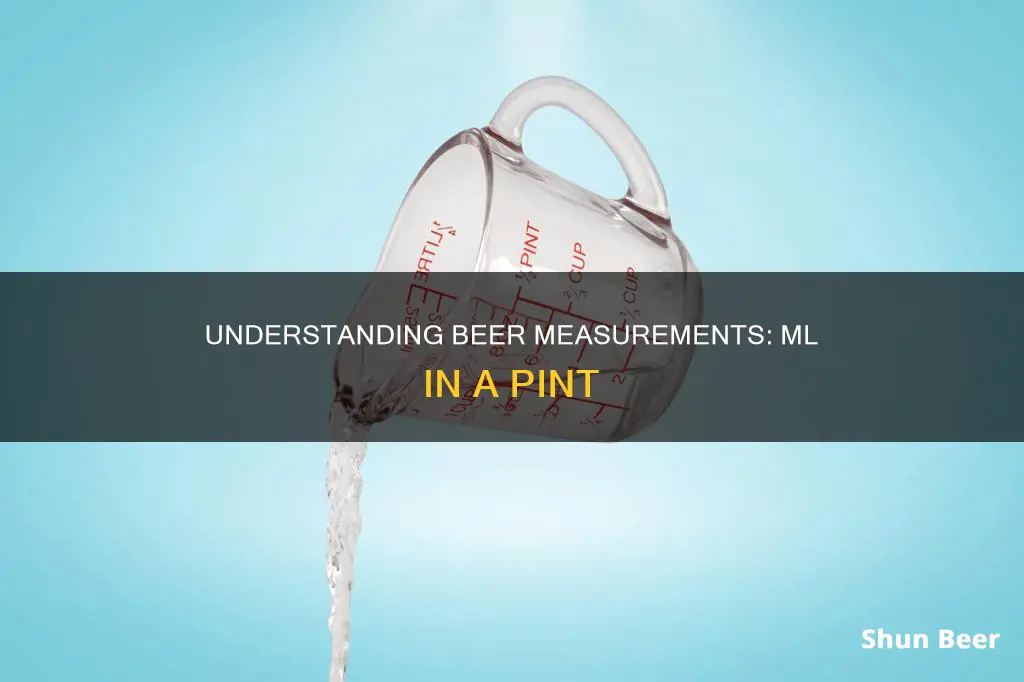
The term pint in New Zealand is colloquial and not a standard measure like in the UK. The country adopted the metric system almost 50 years ago, and while the term pint may be used, it does not refer to the British imperial pint. In reality, the volume of a pint of beer in New Zealand can vary anywhere between 400ml and 570ml, with some sources stating that the most common volume is 425ml. This lack of standardisation can be confusing for consumers, especially those from the UK or Ireland, where a pint is a precise measurement.
| Characteristics | Values |
|---|---|
| Country | New Zealand |
| Unit of volume | Pint |
| Pint in ML | 568 ML |
| Pint in the UK | 568 ML |
| Pint in the US | 473 ML |
| Pint in NZ | Not a defined measure, varies between 400-570 ML |
What You'll Learn
- In NZ, a pint is a colloquial term with no standard measure
- The imperial pint is about 568ml
- In NZ, a pint of beer can vary anywhere between 400ml and 570ml
- In the US, two kinds of pints are used: a liquid pint and a dry pint
- In NZ, there is no legal requirement for beer to be served in standard measures

In NZ, a pint is a colloquial term with no standard measure
In New Zealand, the term "pint" is used colloquially to refer to a large glass of beer, but it is not a standardised measure. While the British imperial pint is about 568 ml, and the US liquid pint is approximately 473 ml, New Zealand adopted the metric system decades ago and does not have a defined measure for a pint. This means that the volume of a "pint" of beer in New Zealand can vary significantly, typically ranging from 400 ml to 570 ml.
The lack of a standardised measure for a pint in New Zealand can be confusing for both locals and visitors, especially those from the UK or Ireland, where the pint is a well-defined measure. When ordering a "pint" in New Zealand, it is not uncommon to receive a glass of beer ranging from 400 ml to 570 ml, depending on the bar or pub. This inconsistency in serving sizes is a source of frustration for many consumers, who feel they are not getting their money's worth.
Adding to the confusion, some bars in New Zealand refer to their glasses as "handles," which typically hold around 440 ml of beer. This term, too, lacks a standard definition and can vary in size between different establishments. Furthermore, the price of a "pint" or a "handle" can vary widely between bars, making it challenging to know how much beer one is getting for their money.
To address this issue, some commentators have suggested that bars should advertise the exact size of the glasses they serve in millilitres, providing transparency to consumers and enabling them to make more informed choices. This would also help ensure that consumers are not being short-changed on the volume of beer they are paying for. However, others argue that creating new standardised glassware across the hospitality industry would be costly and impractical.
In summary, while the term "pint" is commonly used in New Zealand to refer to a large glass of beer, it is not a standardised measure. The volume of a "pint" can vary significantly between different establishments, and consumers often have little way of knowing how much beer they will receive. This lack of standardisation has been a source of debate and frustration for both locals and visitors to New Zealand alike.
Cerveza vs Beer: What's the Difference?
You may want to see also

The imperial pint is about 568ml
The imperial pint is used in the United Kingdom and Ireland and to a limited extent in Commonwealth nations. In the United States, two kinds of pints are used: a liquid pint and a less common dry pint.
New Zealand, a Commonwealth country, converted to the metric system in the 1960s and 1970s. As such, the term "pint" may still be in common use, but it may no longer refer to the British imperial pint. In New Zealand, there is no longer any legal requirement for beer to be served in standard measures. In pubs, the largest size of glass, often referred to as a "pint", varies but usually contains 425ml.
In the British and Irish metrication processes, the pint was replaced by metric units as the legally defined primary unit of measure for trading by volume or capacity, except for the sale of draught beer and cider, and milk in returnable containers. As a supplementary unit, the pint can still be used in all circumstances.
Explore Amber Beer and Vienna Lager: A Comparison
You may want to see also

In NZ, a pint of beer can vary anywhere between 400ml and 570ml
In New Zealand, a pint of beer can vary anywhere between 400ml and 570ml. This is because, while the country adopted the metric system almost 50 years ago, the term "pint" is still used colloquially to refer to a large glass of beer. However, there is no legal definition of a pint in New Zealand, and it is not a recognised measure. As a result, the size of a pint can vary significantly between bars and pubs.
The term "pint" originally comes from the Old French word "pinte" and may ultimately derive from the Vulgar Latin "pincta", meaning "painted". In the past, marks were painted on the side of containers to indicate capacity. The British imperial pint, used in the United Kingdom and Ireland, is about 568ml. This is the standard that many Rugby World Cup visitors to New Zealand may be familiar with.
In New Zealand, a "pint" of beer is often served in a glass ranging from 400ml to 570ml. Some bars may refer to these glasses as "handles", which are typically 440ml. The lack of standardisation can be confusing for consumers, who may not know how much beer they are actually getting. This variation in serving sizes is a result of New Zealand's transition to the metric system, during which there was no standardisation of glass sizes.
To address this issue, some commentators have suggested that bars should start advertising the exact size of the glasses they serve in millilitres. This would provide transparency to consumers and allow them to make more informed choices. Additionally, bars could offer multiple well-advertised pour sizes, such as 425ml, 330ml, or 285ml, instead of a one-size offering called a "pint".
Draft Beer vs Lager: What's the Difference?
You may want to see also

In the US, two kinds of pints are used: a liquid pint and a dry pint
In New Zealand, a pint is not a defined measure, although pints of milk used to be 600ml. In practice, a pint of beer can vary anywhere between 400ml and 570ml. The closest to a standardised measure is a glass engraved with "425ml" at the bottom, which is often used for serving beer.
The dry pint is defined as one sixty-fourth of a bushel, or one-eighth of a dry gallon. It is equal to 550.6104713575ml, or 33.6003125 cubic inches. This is about 11% smaller than the liquid pint. The dry pint is used less commonly than the liquid pint and is mostly used for measuring capacity in cooking.
It's worth noting that the British imperial pint is about 20% larger than the American pint.
Exploring Beer, Whisky, and Rum: Unique Distinctions
You may want to see also

In NZ, there is no legal requirement for beer to be served in standard measures
In New Zealand, there is no legal requirement for beer to be served in standard measures. The country adopted the metric system almost 50 years ago, and while liquids like milk, soft drinks, and beer are sold in millilitres, beer servings in bars are often referred to as "standard or half", "pint or glass", or "large or small". This lack of standardised measures in bars can be confusing for both customers and bar staff.
The term "pint" in New Zealand is colloquial and not a standard measure as it is in the UK. A pint in New Zealand can vary anywhere between 400ml and 570ml, depending on the bar and the type of beer. Some bars may use glasses engraved with a specific volume, such as 425ml or 285ml, as their standard for a pint or half-pint, respectively. However, the actual volume of beer poured into these glasses may be less than the engraved volume due to the head (foam) that forms on top of the beer.
The variation in serving sizes makes it challenging for customers to compare prices between different bars accurately. Some people in New Zealand prefer to drink at home or buy beer from supermarkets, where they can be sure of the volume they are paying for. Additionally, the lack of standardised measures can impact host responsibility and make it difficult to track standard drinks consumed.
To address this issue, some people suggest that bars should advertise the exact size of the glasses they serve in millilitres. This would provide transparency to customers and help them make more informed choices. However, creating new standardised glassware across the hospitality industry could be costly, especially since New Zealand relies heavily on imported glassware.
While there is no legal requirement for standard measures, it is important to note that there are laws and regulations in New Zealand that govern the sale and supply of alcohol, including minimum age requirements and restrictions on licensed premises.
Milligrams in Beer: Pint-Sized Weight Wonders
You may want to see also
Frequently asked questions
The imperial pint is about 568ml. However, in NZ, a pint is not a defined measure, though it is colloquially used to refer to a large glass of beer. The volume of a 'pint' of beer in NZ can vary anywhere between 400ml and 570ml.
There is no legal definition of a pint in NZ. NZ law bans the sale of any food or drink using imperial measures, so it is illegal to advertise a "pint" of beer for sale.
The word "pint" comes from the Old French word "pinte" and perhaps ultimately from Vulgar Latin "pincta", meaning "painted", for marks painted on the side of a container to show capacity.







